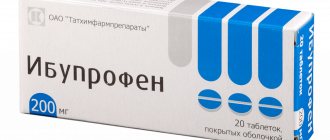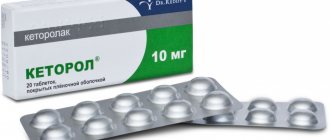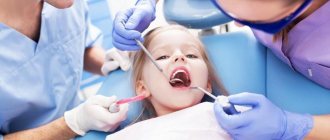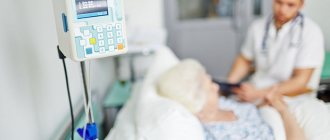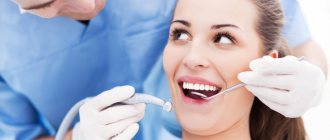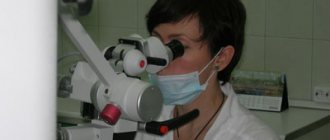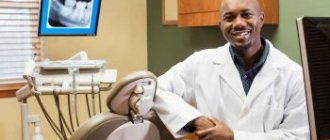The use of ibuprofen in gynecological practice
Probably, almost every woman at least once in her life has encountered such a condition as painful menstruation. For some, pain during menstruation is so severe that it can render a woman completely incapacitated. In other words, pain is not uncommon in a woman’s life. At the same time, in gynecological practice we often have to perform all sorts of invasive interventions, accompanied by pain, sometimes quite severe, for which it is usually not customary to use general anesthesia. In this situation, you have to resort to non-narcotic analgesics, the effectiveness of which can vary quite a lot. In this article we want to touch upon the issue of pain in gynecological practice and offer treatment options for this condition.
Dysmenorrhea or painful menstruation
are one of the most common reasons why women miss work or school. In many state-owned enterprises, there is still such a thing as “women’s day,” which allows a woman to experience “critical days” outside of the workplace once a month.
Dysmenorrhea is divided into primary and secondary. Under primary dysmenorrhea
understand painful menstruation in the absence of pathological changes in the genital organs.
With secondary dysmenorrhea,
painful menstruation is caused by the presence of gynecological diseases. Most often these include endometriosis, inflammatory diseases of the genital organs, uterine fibroids and others. According to various authors, the incidence of dysmenorrhea depending on age ranges from 60 to 92%. It is obvious that primary dysmenorrhea occurs mainly in adolescents, while secondary dysmenorrhea is typical for older age groups.
Primary dysmenorrhea usually develops 6–12 months after menarche, when the first ovulatory cycles appear. Symptoms of dysmenorrhea usually occur with the onset of menstruation, rarely the day before, and are characterized by cramping, aching, jerking, bursting pain that can radiate to the rectum, appendages and bladder. In addition, nausea, vomiting, headache, irritability, bloating and other autonomic phenomena may occur.
Among adolescents, the peak incidence of dysmenorrhea occurs at 17–18 years of age, that is, at the time of the final formation of menstrual function and the formation of the ovulatory menstrual cycle. This pattern, in particular, indicates the significant role of ovulation in the pathogenesis of primary dysmenorrhea.
Although there is still no clear idea about the etiology of primary dysmenorrhea, most researchers agree that the leading role in the development of this disease is played by an imbalance of prostaglandins in the uterus
.
As early as 1978, it was shown that prostaglandin F2a (PGF2a) and prostaglandin E2 (PGE2) accumulate in the endometrium during menstruation and cause symptoms of dysmenorrhea [1]. Prostaglandin F2a and PGE2 are synthesized from arachidonic acid through the so-called cyclooxygenase pathway. The activity of this enzyme pathway in the endometrium is regulated by sex hormones, more precisely, by sequential stimulation of the endometrium, first with estrogens and then with progesterone. By the time of menstruation, a large concentration of prostaglandins accumulates in the endometrium, which are released due to lysis of endometrial cells. Prostaglandins released from the cells act on the myometrium, which leads to alternating constriction and relaxation of smooth muscle cells. Uterine contractions caused by prostaglandins can last several minutes, and the pressure developed in the uterus can reach 60 mm Hg. Prolonged contractions of the uterus lead to the development of ischemia and, as a consequence, to the accumulation of anaerobic metabolic products, which, in turn, stimulate C-type pain neurons. In other words, primary dysmenorrhea can be called “uterine angina.”
The role of prostaglandins in the development of primary dysmenorrhea is confirmed by a study that found that the concentration of prostaglandins in the endometrium correlates with the severity of symptoms, that is, the higher the concentration of PGF2a and PGE2 in the endometrium, the more severe the dysmenorrhea [2].
Many factors can modulate the effect of prostaglandins on the uterus. For example, vigorous exercise may increase uterine tone, possibly by reducing uterine blood flow. Many female athletes note that intense training during menstruation significantly increases the symptoms of dysmenorrhea. In addition to affecting the uterus, PGF2a and PGE2 can cause bronchoconstriction, diarrhea and hypertension, so, in particular, diarrhea most often accompanies primary dysmenorrhea.
For high production of prostaglandins in the endometrium, sequential exposure to estrogens and then progesterone
. It is obvious that women with an anovulatory menstrual cycle extremely rarely suffer from primary dysmenorrhea due to their lack of sufficient progesterone secretion. In this regard, the presence of ovulation is one of the factors causing the symptoms of dysmenorrhea.
The most common drugs for treatment
primary dysmenorrhea are
oral contraceptives and non-steroidal anti-inflammatory drugs
(NSAIDs). The prescription of oral contraceptives is mainly aimed at stopping ovulation, since, as noted above, it is the ovulatory menstrual cycle that provides cyclic stimulation of the endometrium, which contributes to the accumulation of prostaglandins responsible for the development of symptoms of dysmenorrhea. This method of treatment is quite effective, but when choosing it it is necessary to take into account a number of factors. Firstly, the majority of patients with primary dysmenorrhea are adolescents who are not sexually active, for whom the problem of contraception accompanying the treatment is not so relevant, and the belief in the inevitable gain of excess weight “from hormones” is extremely strong. Secondly, it is not possible to prescribe oral contraceptives in all cases, since they have a number of contraindications. Thirdly, the therapeutic effect from the prescription of oral contraceptives develops only after 2–3 months from the start of their use, which makes their use irrational in cases of particularly severe disease. Thus, the use of oral contraceptives for the treatment of primary dysmenorrhea is optimal in cases where the patient, in addition to treatment, requires reliable contraception, as well as in cases of mild to moderate symptoms.
Another equally effective approach to the treatment of primary dysmenorrhea is the prescription of NSAIDs, in particular the drug ibuprofen
(Nurofen)
, which is most widely used in world clinical practice.
Nurofen (ibuprofen) is a derivative of phenylpropionic acid. Nurofen inhibits the synthesis of prostaglandins by inhibiting the activity of cyclooxygenase. After oral administration, ibuprofen is rapidly absorbed from the gastrointestinal tract, its maximum concentration in the blood plasma is determined after 1–2 hours. Ibuprofen is metabolized in the liver, excreted by the kidneys unchanged and in the form of conjugates, the half-life is 2 hours. Unlike other NSAIDs, side effects are extremely rarely observed when using Nurofen, which are mainly characterized by mild digestive disorders. For the treatment of primary dysmenorrhea, Nurofen is prescribed at an initial dose of 400 mg, then the drug is prescribed at a dose of 200–400 mg every 4 hours, the maximum daily dose of Nurofen is 1200 mg. Obviously, the dose of Nurofen should be selected depending on the severity of the symptoms of the disease.
If the analgesic effect of Nurofen is not enough, it is possible to use the combination drug Nurofen Plus
. This drug combines ibuprofen with codeine, an analgesic that acts on opiate receptors in the central nervous system. This combination gives a more pronounced analgesic effect.
In general, the use of NSAIDs for the treatment of primary dysmenorrhea has a number of advantages over the use of oral contraceptives. Unlike oral contraceptives, which should be taken for several months, NSAIDs are prescribed only for 2-3 days a month, which, on the one hand, is more convenient, and on the other, more cost-effective. In addition, NSAIDs not only effectively neutralize the negative effects of prostaglandins on the uterus, but also eliminate other symptoms of dysmenorrhea, such as nausea, vomiting and diarrhea.
Objectively speaking, it was the high effectiveness of NSAIDs in treating not only the main but also accompanying symptoms of primary dysmenorrhea that confirmed the hypothesis about the role of prostaglandins in the pathogenesis of this disease, and therefore it is obvious that NSAIDs are first-line drugs in the treatment of primary dysmenorrhea
.
Although primary dysmenorrhea is one of the most common gynecological diseases accompanied by pain, a number of other gynecological pathologies often require the use of effective analgesics.
Secondary dysmenorrhea
, as noted above, is due to the presence of organic disorders of the genitals (Table 1).
There are a number of factors that help distinguish secondary dysmenorrhea from primary.
1. Symptoms of dysmenorrhea appear during the first or second menstrual cycle after menarche (congenital obstructive malformations).
2. Symptoms of dysmenorrhea first appear after the age of 25 years.
3. Presence of gynecological diseases: infertility (endometriosis, inflammatory diseases of the pelvic organs or other causes of adhesions are assumed), heavy menstruation or intermenstrual bleeding (adenomyosis, uterine fibroids, polyps are assumed), dyspareunia.
4. Lack of effect or its insignificant severity from therapy with NSAIDs and/or oral contraceptives.
The most common cause of secondary dysmenorrhea is endometriosis
. Characteristic symptoms of endometriosis are: the appearance of progressively increasing pain that occurs immediately before or during menstruation; dyspareunia, painful bowel movements, premenstrual spotting and polymenorrhea; pain over the pubis, dysuria and hematuria; infertility. A number of patients may not identify pain as an acquired phenomenon, but simply note that they have painful menstruation, although most indicate increased pain during menstruation. The pain is most often bilateral and ranges in intensity from mild to extremely severe; pain is often associated with a feeling of pressure in the rectum and can radiate to the back and leg. Constant “unpleasant sensations” throughout the menstrual cycle, intensifying before menstruation or during coitus, may be the only complaint presented by a patient with endometriosis. The cause of the pain has not been fully established; it is assumed that it may be associated with the phenomenon of “miniature menstruation” of endometriotic explants, which leads to irritation of the nerve endings. The disappearance of pain during the induction of amenorrhea in patients with endometriosis, that is, the elimination of cyclic hormonal effects on endometrioid explants, in fact, proves the mechanism of pain syndrome.
However, pain is not always associated with endometriosis, even in cases where the disease is severe. For example, bilateral large endometrioid ovarian cysts are most often asymptomatic unless they rupture, while severe discomfort may be a consequence of a minimal number of active endometrioid heterotopias.
Despite the fact that there is a completely definite pathogenetic therapy for endometriosis, including the use of GnRH agonists and 19-norsteroid derivatives, quite often in the first stages of treatment, and sometimes over longer periods, it is necessary to add analgesics to the main drugs. This is due to the fact that the basic drugs do not have their maximum effect immediately, and in some cases the basic drugs are not able to completely eliminate the pain syndrome. Thus, the drug Nurofen or Nurofen Plus also finds its place in the treatment of endometriosis.
Everyday gynecological practice
cannot do without procedures such as the introduction and removal of intrauterine devices, treatment of cervical pathology, endometrial biopsy, hysterosalpingography, etc. Of course, in most cases, these interventions do not require the use of pain medications at all. The era of abortions performed without any anesthesia has not yet been forgotten. One could simply shout at the patient - “be patient, they didn’t tolerate this during the war” - and that would be the end of it, but in modern conditions this is completely unacceptable. Moreover, all of the above procedures can be quite well anesthetized and thereby achieve good emotional tolerance of these interventions. For this purpose, it is also possible to use Nurofen Plus, preferably 20–30 minutes before the procedure and subsequently after its completion. Taking this drug once or twice, depending on the severity of the pain syndrome, will provide the patient with pleasant memories of a caring doctor.
We would like to touch upon one more, fairly common pain syndrome within the framework of this story. We are talking about the so-called pelvic ganglioneuritis
. This is a variant of radiculitis, in which the nerve trunks exiting in the pelvic area are pinched. Patients with this disease most often complain of recurrent pain in the iliac regions. As a rule, the examination fails to reveal any signs of an inflammatory process in the uterine appendages or any other pathological changes. The pain syndrome in such patients is quite well controlled by taking analgesics from the NSAID group, in particular Nurofen.
Since 2001, in our clinic for the treatment of patients with uterine fibroids
We began to use the method of uterine artery embolization. After the procedure, patients usually experience pain of varying severity. The duration of this syndrome also varies, but on average it is 8 days. We used various pain relief regimens in this category of patients and settled on a regimen that included the use of Nurofen and Nurofen Plus. In particular, we were able to note a more pronounced analgesic effect of this drug, a rapid onset of effect and good tolerability.
Thus, Nurofen and Nurofen Plus are widely used in gynecological practice, effectively relieving women of pain.
Literature:
1. Ylikorkala O, Dawood MY New concept in dysmenorrhea. Am J Obstet Gynecol 1978; 130:833
2. Chan WY, Dawood MY, Fuchs F. Relief of dysmenorrhea with the prostaglandin synthetase inhibitor ibuprofen: effect of prostaglandin levels in menstrual fluid. Am J Obstet Gynecol 1979; 135:102.
Treatment of pain during menstruation
Pain is considered severe if it interferes with your daily activities, and such pain affects about 10% of women and is called dysmenorrhea. Remember, this is a serious symptom that is common to many conditions, including endometriosis or fibrosis, which means consulting a doctor is required.
Below are some ways to relieve period pain:
Regular physical activity and generally staying physically fit can reduce period pain. Pain relievers that reduce the effects of prostaglandins may help with menstrual pain. These painkillers include non-steroidal anti-inflammatory drugs (NSAIDs for short). Relaxation techniques, bed rest and simple measures such as applying heat to the lower abdomen (in the form of a warm water bottle or heating pad) can be very effective.
Interaction with other drugs
Ibuprofen was created back in 1953 and is therefore well studied. Here we will briefly list its interactions with common drugs - this is mainly a group of cardiovascular drugs, some antibiotics. A complete list of drug interactions should be read in the instructions for the drug.
- Reduces the effect of ACE inhibitors, beta-blockers and some diuretics, such as furosemide.
- The effect may be enhanced when taken with anticoagulants.
- The activity of amlodipine decreases.
- Caution should be used when taking warfarin, methotrexate and lithium together.
- Interactions have been noted with cardiac glycosides, quinolone antibiotics, ethanol, barbiturates, rifampicin, phenylbutazone, cyclosporine, mifepristone, tacrolimus, zidovudine, cefoperazone, cefotetan, valproic acid.
Some numbers
Some statistics. In the UK, approximately 24 million NSAIDs are prescribed per year. 70% of people over 70 years of age take NSAIDs once a week, and 34% daily. In the United States, up to 6 billion worth of NSAIDs are sold annually. As a result, the risk of developing gastrointestinal bleeding (GIB) increases 3–5 times, perforation by 6 times, and the risk of death from complications by up to 8 times. Up to 40–50% of all cases of acute gastrointestinal tract infections are associated with NSAIDs.
This problem is also relevant in our country, for example, according to the Scientific Center for Cardiovascular Surgery named after. A.N. Bakulev, out of 240 patients taking aspirin daily, even in small doses, gastroscopy revealed lesions of the stomach and 12 p.c. in 30% (of which ulcers - in 23.6%, erosions - in 76.4%). A similar picture was observed among colleagues from the All-Russian Research Institute of Rheumatology of the Russian Academy of Medical Sciences - in 2126 patients taking NSAIDs without “covering” (protection) of the stomach, erosions and ulcers of the gastroduodenal zone were found in 33.8% of cases. These are very impressive and dramatic numbers of complications from taking NSAIDs, considering the number of people using these drugs in developed countries.
Contraindications:
- Hypersensitivity to the components of the drug.
- Bleeding disorders, hemophilia.
- Hematopoietic disorders.
- Erosive and ulcerative lesions of the gastrointestinal tract in the acute stage, bleeding in the gastrointestinal tract.
- Kidney or liver failure.
- Severe heart failure.
- The period after coronary artery bypass surgery.
- “Aspirin triad” (aspirin intolerance, nasal polyps and bronchial asthma).
- Diseases of the optic nerve.
- Caution should be exercised when taking other NSAIDs.
- Simultaneous use of medication and alcoholic beverages is not recommended.
Instructions for taking Ibuprofen for adults and children.
- A single dosage for an adult is 200 mg; in case of severe pain, you can take 400 mg, the dosage frequency is 3-4 times a day, but not more than 1200 mg per day.
- A single dose for a child over 6 years old is 200 mg, can be taken 3-4 times a day. The maximum dosage for children per day differs by age as follows: for children 12-17 years old - 1000 mg; for children aged 6 to 12 years - 800 mg.
Ibuprofen Welfarm for adults
How many days can you take Ibuprofen?
The drug is taken for 2-3 days; if the patient’s condition does not improve or becomes worse, it is necessary to stop taking it and consult a doctor.
special instructions
- Ibuprofen is prescribed in a short course - three days. If therapy lasts 10 days or more, you should consult a doctor.
- Elderly patients need to carefully monitor the tolerability of the drug, as they are more likely to experience side effects.
- May temporarily reduce female reproductive function (the effect disappears after discontinuation).
- It may affect the ability to drive vehicles, so if the patient notices lethargy or drowsiness, he should refrain from driving vehicles and other activities where reaction speed is required.
Ibuprofen for children
Side effect
- Like all medications, Ibuprofen can cause allergic reactions: skin itching, urticaria, Quincke's edema, anaphylactic reactions, incl. anaphylactic shock. In this case, you should stop taking the drug and consult a doctor.
- The following side effects may be observed on the part of the digestive system: pancreatitis, nausea, vomiting, erosive and ulcerative lesions of the gastrointestinal tract, stomach and abdominal pain, stomatitis, liver dysfunction, hepatitis.
- Genitourinary system: polyuria, renal dysfunction, renal failure, edema, cystitis, nephrotic syndrome, interstitial nephritis.
- Nervous system and sensory organs: irritation and dry eyes, ringing in the ears, hallucinations, psychomotor agitation, confusion, headaches, anxiety, irritability.
- Respiratory system: allergic rhinitis, bronchospasm, shortness of breath.
- Cardiovascular system: agranulocytosis, leukopenia, increased pulse, hypertension, heart failure.
